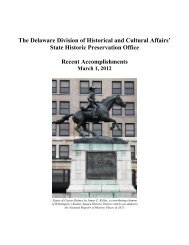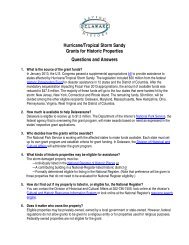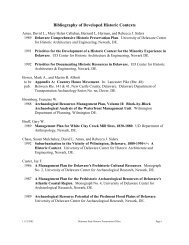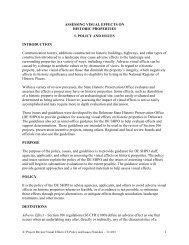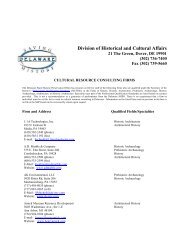Report of the Archaeological Investigations of the New Castle Court ...
Report of the Archaeological Investigations of the New Castle Court ...
Report of the Archaeological Investigations of the New Castle Court ...
You also want an ePaper? Increase the reach of your titles
YUMPU automatically turns print PDFs into web optimized ePapers that Google loves.
NEW CASTLE COURT HOUSE PLAZA<br />
NEW CASTLE, DELAWARE<br />
3.0 FIELD RESULTS<br />
was initially identified within EU 6 and thickened toward <strong>the</strong> eastern and sou<strong>the</strong>rn edges <strong>of</strong> <strong>the</strong><br />
plaza. The depth <strong>of</strong> this deposit ranged from less than 0.1 ft. within EU 6 to a maximum<br />
measured depth <strong>of</strong> 1.1 ft. within EU 11 and a high density <strong>of</strong> artifacts was noted. Hue and chroma<br />
for this layer ranged from dark yellowish brown (10YR 4/4), brown (10YR 5/3), and yellowish<br />
brown (10YR 5/4) silt loam to silt clay loam mottled with brown (10YR 4/3), yellowish brown<br />
(10YR 5/6), and brownish yellow (10YR 5/6) silt loam with brick and mortar inclusions. The<br />
third fill deposit corresponded to a distinct layer <strong>of</strong> beach sand that was originally identified<br />
during <strong>the</strong> 1995 plaza excavation. The munsell color <strong>of</strong> this lower sand deposit was slightly<br />
darker when compared to <strong>the</strong> upper sand layer and its texture was less coarse. This layer was<br />
comprised <strong>of</strong> brown (10YR 4/3, 5/3), dark yellowish brown (10YR 4/4, 4/6), yellowish brown<br />
(10YR 5/4), to light yellowish brown (10YR 6/4) sand to loamy sand with less than 40 percent<br />
pea gravel and thickness ranged from approximately 0.4 to 0.7 ft. within <strong>the</strong> excavated units. The<br />
lowest fill deposit corresponded to a thin approximately 0.2 to 0.35 ft. wide artifact rich layer that<br />
directly overlay an alluvial wash deposit or intact B horizon. The base fill, originally assigned<br />
Feature 19 when it was initially identified, was encountered within 10 excavation units on <strong>the</strong><br />
eastern plaza (corresponding to EUs 6 through 9, and 23 through 28). This stratigraphic unit<br />
typically consisted <strong>of</strong> dark grayish brown (10YR 4/2) to brown (7.5YR 4/3, 10YR 4/3) loamy<br />
sand to silt loam with brick and mortar inclusions as was similar in appearance and artifact<br />
content to <strong>the</strong> second fill layer. Overlying a portion <strong>of</strong> <strong>the</strong> subsoil within <strong>the</strong> sou<strong>the</strong>astern most<br />
units, was a thin alluvium, ranging in thickness from 0.01 to 0.31 ft., comprised <strong>of</strong> yellowish<br />
brown (10YR 5/4) silt loam to silt. Subsoil on <strong>the</strong> east plaza consisted <strong>of</strong> yellowish brown (10YR<br />
5/4, 5/6) silt loam to silty clay loam.<br />
Table 1. Stratigraphic Units within <strong>the</strong> Eastern Plaza<br />
SU Level Description TPQ Mean Standard Deviation Corresponding Unit and Level<br />
Date Range<br />
Designations<br />
A Organic Accumulation 1895 1835.8 1766.5-1905.0 1.1, 4.1, 5.1, 6.1, 7.1, 8.1, 9.1, 10.1, 11.1, 12.1<br />
B Upper Sand Deposit 1810 1790.3 1767.1-1813.5 1.2, 4.2, 5.3, 6.2, 7.2, 8.2a, 8.2b, 9.2, 10.2,<br />
10.3, 11.2, 12.2<br />
C Upper Silt Loam Deposit 1795 1779.3 1751.6-1807.0 4.3b, 5.5, 6.3, 7.3, 8.3, 9.3, 10.4, 11.4, 12.4<br />
D Lower Sand Deposit 1779 1754.9 1726.4-1783.3 1.3, 4.4, 5.6, 6.4, 7.4, 8.4, 9.4<br />
E Lower Silt Loam Deposit 1810 1778.6 1753.7-1803.5 6.5, 7.5, 8.6, 9.5, 9.5a, 9.6, 23.2, 24.2, 26.2,<br />
(Feature 19)<br />
27.2, 27.3, 28.2, 28.3<br />
F Alluvium 1779 1785.6 1758.6-1812.6 9.9, 24.3, 27.4, 28.4<br />
G Subsoil (B horizon) --- --- --- 1.5, 4.6, 5.8, 6.6, 7.6, 8.11, 9.10, 23.5, 24.8,<br />
25.5, 26.3, 27.5, 28.5<br />
3.1.1 ORGANIC ACCUMULATION (SU A)<br />
A variety <strong>of</strong> artifacts totaling 200 were collected from <strong>the</strong> accumulated organic layer at <strong>the</strong> top <strong>of</strong><br />
<strong>the</strong> excavation units. Recovered items include floral and faunal remains which includes a seed<br />
and two bone fragments; personal items such as metal and porcelain buttons and a ball clay pipe<br />
bowl fragment; buff-bodied ear<strong>the</strong>nware, redware, creamware, pearlware, and white salt-glazed<br />
stoneware ceramic sherds; unidentified bottle glass; architectural items such as cut/wrought nails,<br />
mortar and brick fragments, and window glass. Modern items were also recovered, such as coal<br />
fragments, a drill bit, a machine made light bulb fragment, and wire nails that accumulated within<br />
<strong>the</strong> brick voids. The condition <strong>of</strong> <strong>the</strong> east plaza was largely undisturbed. The only noted<br />
disturbance related to small fill deposits adjacent to <strong>the</strong> interior portions <strong>of</strong> <strong>the</strong> foundation walls<br />
(attributed to erosion <strong>of</strong> <strong>the</strong> original foundation material). These pockets <strong>of</strong> (recent) fill were<br />
removed separately and typically did not contain any cultural material. A calculated TPQ <strong>of</strong> 1895,<br />
21





